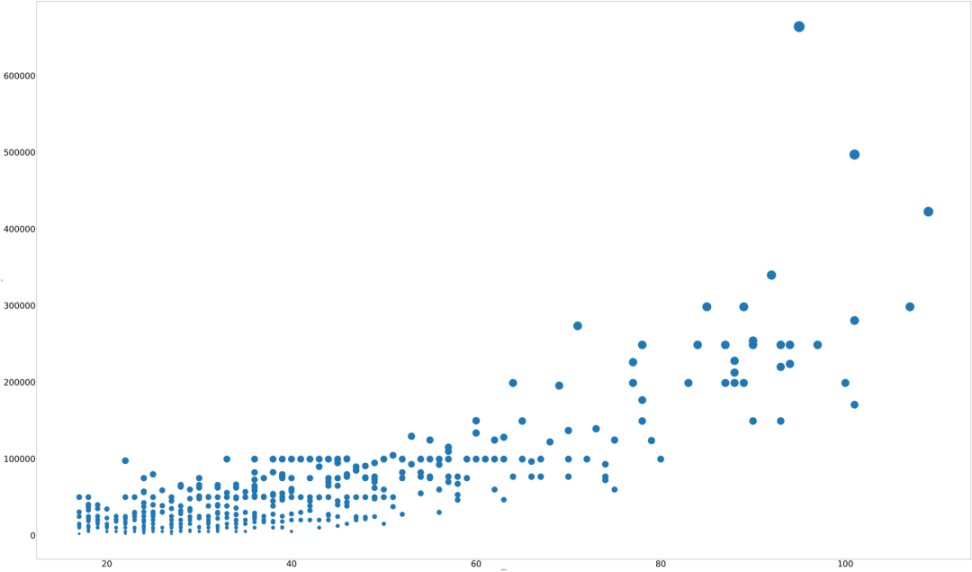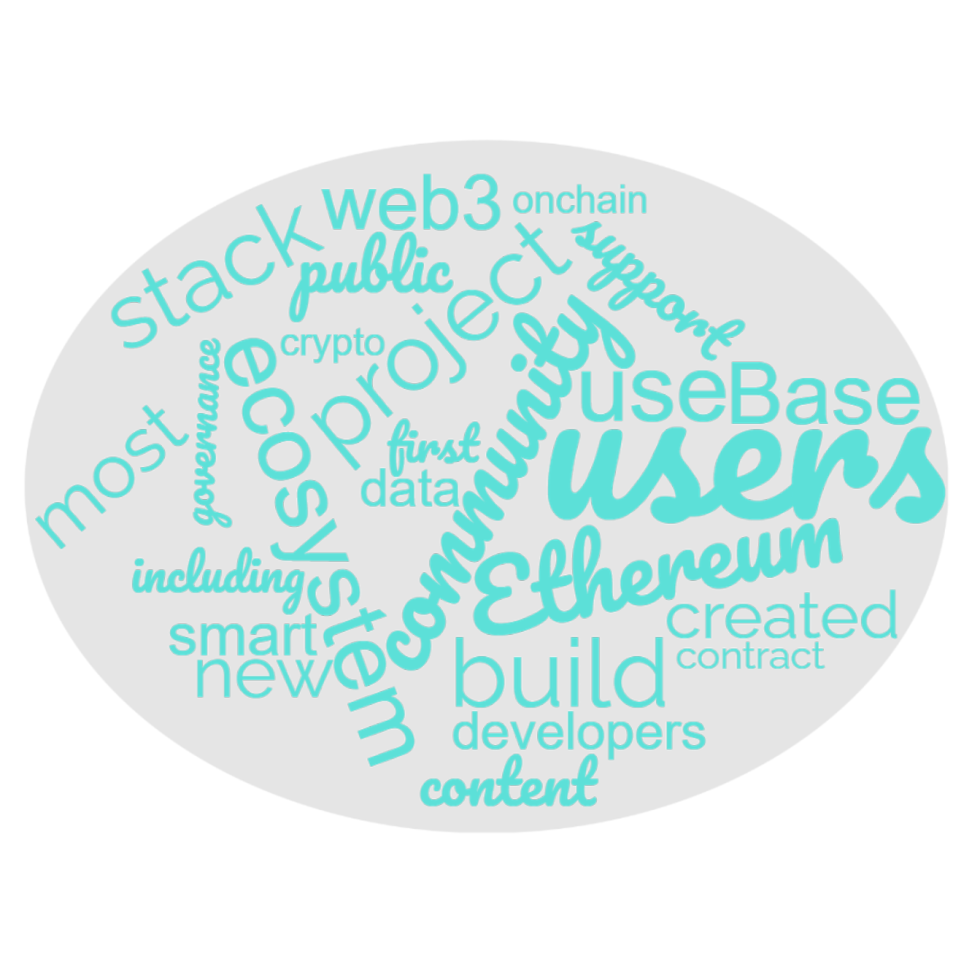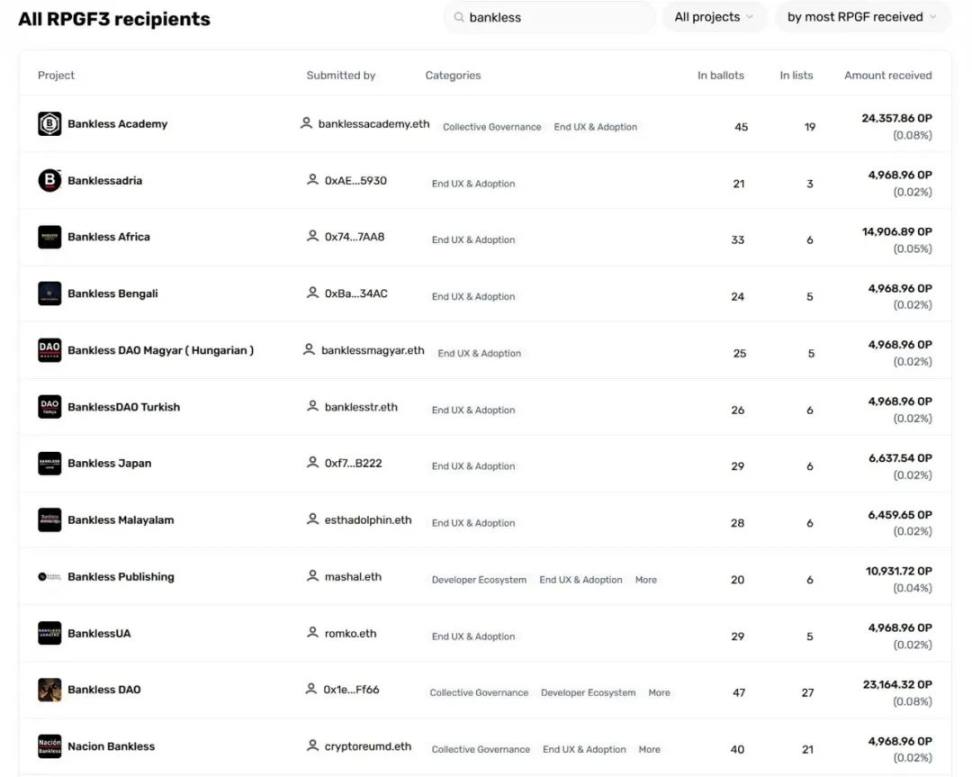Author: Lykan, LXDAO
Organized by Optimism Collective, the highly anticipated public goods funding project RetroPGF Round 3 was announced on January 12 got the result. After crawling and briefly sorting out all candidate project information, we have the following findings:
Overview
A total of 643 projects participated in the selection in this round, an increase of more than 230% compared with the 195 projects in the previous round (Round 2). But the number of voters (badgeholders) responsible for voting and allocating OP funding only increased from 70 to 146, an increase of just over 100%. In the second round of voting, each voter had to examine 20 to 40 projects on average. Many voters said that there were "too many projects" and "cannot handle them." So will this situation be further aggravated in the third round?
No.
Optimism cleverly adds a "list" function. Any voter can add several items to the public list and provide reasons for including them on the same list. In this way, other voters who are not yet familiar with the project can quickly locate the areas they like and are good at through various lists and assign OPs to them.
Similar to previous rounds, this round of RetroPGF still uses the allocation OP - take the median - screen out eligible projects - redistribute proportionally OP’s process. All projects are required to fill in their profiles and contributions in as much detail as possible, and quantify their impact within the Optimism ecosystem through data as much as possible. Voters have one month to review the projects and allocate 30 million OP tokens to the participating projects based on their own judgment to cast their ballot. The principle of voting and allocating OP is to match the impact of the project with the profit as much as possible. After the voting ends, Optimism Collective will take the median OP received by each project, filter out projects with less than 17 votes and less than 1500 median OP, and then use the median OP of the remaining projects as their respective weights, and re- Calculate the number of OPs each project deserves. In the end, 501 of the 643 projects that participated in this round received OP funding.
In addition, although for the sake of unification, this article refers to all units participating in the selection as "projects", there are 112 units participating in the selection in the name of individuals.
Some basic analysis
In this round of voting, Optimism Collective has set up four major categories (Label). Tags are not unique and multiple tags can be added to a project at the same time.
1. OP stack
(OP Stack)
Projects that contribute to the efficiency, security, reliability, and visibility/impact of the entire Optimism stack and ecosystem. A total of 165 projects participated in this round, and 146 projects received funding.
2. Consortium governance
( Collective Governance)
Projects that have an impact on Optimism Collective governance or assist in the introduction of new governance members. A total of 104 projects participated in this round and all received funding.
3. Developer Ecosystem
( Developer Ecosystem)
Projects that have an impact on developers in the Optimism ecosystem or help introduce new developers. A total of 304 projects participated in this round, and 252 projects received funding.
4. End user experience and usage
(End User Experience & Adoption)
Influence end users, or assist in launching new projects. A total of 472 projects participated in this round, and 355 projects received funding.
Among all the projects that participated, 112 participated in their own names, and 72 of them received funding. There were 531 entries in the name of projects (collectives), of which 429 were funded. The nominal pass rate for individuals (64.29%) is much lower than the nominal pass rate for projects (80.79%).
The distribution of votes and funding received for all participating projects is as shown in the figure:
< img src="https://cdn-img.panewslab.com//panews/2022/2/24/images/48d6ce270994f676e1a2b5033edf2161." alt="In-depth interpretation of RetroPGF Round 3: Who is harvesting the wool?">
Vote count for all selected items
 < /p>
< /p>
Distribution of funding received
As you can see, no project received 0 votes, and the project with the smallest number also received 4 votes. At the same time, although there are exceptions for some projects, generally speaking, the more votes a project receives, the more funding it will receive.
However, it is the same vote, but the value (number of OPs) represented is different. The distribution of the number of votes received by all projects and the average OP received per vote is as shown in the figure:

Distribution of the number of votes received by all projects and the average OP per vote
It can be seen that the average number of OPs received per vote for most projects is concentrated around 2,000. Among them, the average distribution of OPs per ticket in the three major categories of OP stack, developer ecosystem, end-user experience and usage is similar. However, the average OP vote per vote for consortium governance projects with a 100% pass rate lags far behind. Although voters seem relatively more willing to vote for governance projects, they are not willing to allocate too many OPs.
Word play
1. Describe contributions The wording of Influence. After preliminary analysis of the contribution content of funded projects and elimination of irrelevant words such as function words, the 25 most frequently occurring words are as follows:

The 25 words with the highest frequency
The most mentioned word is community. Indeed, Optimism’s ability to occupy a place in the field of public goods also relies on the power of the community.
The words next to community are build and ecosystem.
Although there is no unified definition, web 3 also appears 114 times.
Although there are 104 projects labeled with governance, the word only appears 63 times.
In August 2023, Optimism and Base reached a partnership, and Base was mentioned 65 times in the contributions of all projects in this round.
2. Words used to describe the impact of the content
Each The 25 most frequently occurring words in the project’s impact content are as follows:

The 25 words with the highest frequency of occurrence in the influencing content of each project
The difference from contribution is , many projects like to write down their impact on users. Tongue twister: The participating projects rarely mention the word "contribution" in their contribution content, but they love mentioning "impact" in their impact content. The word impact appears 97 times in total. Also thanks to the partnership, Base also appeared 67 times. The participating projects produced a total of 59 “firsts”. Although it does not seem to be particularly directly related to public goods, the word NFT still appears 93 times.
In addition, although the fields and forms of participating projects are different, 17 projects still mentioned collective governance, and another 7 projects mentioned client diversity.
Strange projects
In this round of RetroPGF, although most of the participating projects It is more in line with the definition of "public goods", but there are still some slightly "weird" projects. The “strange” thing about some projects is that they seem to have little to do with public goods. Others, although they can be barely defined as public goods, do not seem to require donations and can give opportunities to projects in greater need. For example:
1. Messari

Messari is a very powerful research institution in the blockchain field. I read their research reports every day and benefit a lot from them. But their application for public goods funding is indeed a bit confusing.
Messari mentioned that his main contribution is the number of subscribers to the Newsletter. Their Newsletter is updated every working day, and almost all the content is originally collected by Messari, including research reports in various fields and a summary of proposals from major DAOs.
Messari has a very mature business model. Although they have not announced revenue details, financial reports, etc., as a 2B company with several years of history and a customer unit price of hundreds or thousands of dollars, Messari may be much richer than most projects that apply for funding. This time Messari received 38 votes and ended up with nearly 25,000 OPs. Perhaps Messari does have a unique or even irreplaceable contribution, but as a very wealthy company, their profit will probably be much higher than their impact. There must be other projects that need those 25,000 OPs more than they do.
2. Bankless bucket

Bankless DAO was full of controversy when it applied for funding from Arbitrum before. This time in Optimism, Bankless had as many as 12 clones apply for funding, and the number of votes was concentrated between 20 and 50, with a total of 116271.14 OPs funded.
Bankless DAO, as always, dumps a bunch of tweets with thousands of views and Instagrams where interactions occasionally reach double digits as proof of influence. Publishing, Africa and other sections that are closely related to DAO not only appear in DAO's contribution statement, but also apply for funding separately as projects. It really makes people suspect that it is an organized harvest.
3. DeFi protocols such as Synthetix

DeFi is the future of finance. As major DeFi protocols continue to develop and grow, they will surely occupy a place in the financial market.
However, the DeFi protocol is relatively simple. Among the four major categories divided this time, only the end-user experience category seems to be somewhat relevant.
In addition, the income from these agreements is very considerable. TVL can cost millions or even hundreds of millions. With the blessing of its own tokens, the gap between actual impact and profit will most likely be much smaller than that of projects with no stable source of income and stronger public goods attributes (the fact is Many DeFi protocols do not announce their revenue, making it difficult for voters to estimate the gap between their impact and profits). It is true that distributing additional tokens will indeed attract more users, but the users attracted in this way are not necessarily as sticky or involved as infrastructure and open source protocol projects.
Matthew Effect
The "Matthew Effect" comes from the Gospel of Matthew. Describes the result that advantages tend to produce more advantages, leading to an enrichment of resources at the top.
Continuing from the previous section, although Optimism Collective has made many efforts to avoid this situation, for example, the default project display order is "random", such as Introduce list function. The actual funding results do not show a strong Matthew effect, but it still does not prevent many projects that do not need funding very much from relying on their own reputation to collect OP from projects that are more in need of funding.
A little immature suggestion: Future RetroPGF funding can introduce a dedicated back-tuning team or release back-tuning bounty tasks to make the participating projects more complete. The background information, such as whether there are physical companies off the chain, and the income profile on/off the chain, can make the information related to project profits more complete and sufficient, and allocate funds to projects in greater need as much as possible. In addition, although RetroPGF is a retrospective incentive, some special awards can also be set up for new projects with potential, so that some projects that have just started but have great potential can receive rewards.
Summary and outlook
It is different from Arbitrum, which is also an Optimistic Rollup, using ARB to stimulate the DeFi protocol. , Optimism’s OP funding focuses on the field of public goods, encouraging projects/individuals to contribute to system ecology and infrastructure. Through three rounds of RetroPGF, Optimism has not only funded the groundbreaking of many fledgling projects, but also continued to inject blood into many existing projects.
Although there is still no extremely complete and quantifiable evaluation and funding plan in the field of public goods, Optimism is also the organization that has gone the furthest on this road. . Through constant review and iteration, Optimism’s retroactive incentive system will surely be able to further grow, flourish, and make the entire ecosystem better.
 Alex
Alex

 < /p>
< /p>









